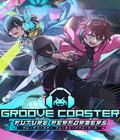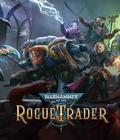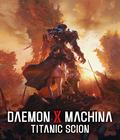Daemon X Machina: Titanic Scion is set in the distant future. The world has been ravaged by a combination of nonstop wars and a deadly but potent substance called Femto. The remains of humanity live on the surface, which is infested by horrible monsters called Immortals. In the skies above live the Outers, a race of "evolved" humans who were used as slaves by humanity, broke free, and now rule the old types of humans with an iron fist. Players take control of one of these Outers, a member of an elite force called the Neun, who is forced to go on the run after the government attempts to use them as part of an evil experiment. Left with nothing but revenge, your protagonist joins up with the human resistance to fight the Outers and get revenge.
Titanic Scion's plot is pretty forgettable. It's more coherent and better put together than the original game, but not a lot actually happens in this game. You spend most of your time slowly introducing the bad guy faction, and then you beat them up, and the plot ends. There are no real significant twists, and none of the cast manages to shine. The game does a pretty poor job of qualifying what separates an Outer from a human, which makes any twists and turns feel lackluster. It's still an improvement over the original game, and at the very least, the plot stands better on its own.
Titanic Scion does a pretty unusual twist for a sequel and mostly drops the defining feature of the original game. You are no longer piloting a giant robot. Instead, your character has an Iron Man-like suit of armor called an exosuit. Like the robots from the previous game, this can be customized with different pieces of armor for your arms, legs and body, but you're limited to more human-like designs for obvious reasons. Although you're not piloting a giant robot, there's still a fair amount of similarity in the game design. Your overall goal is to mix and match various pieces of armor with different stats and skills to create an optimized build to fight foes. This can range from heavy armor designed to take tons of hits to light armor that can easily fly around the battlefield.
Weaponry is also more standardized. You can carry and equip up to four different handheld weapons or shields at any given time. Most weapons can be dual-wielded, but heavy weapons require both hands to use. You're also able to equip a shoulder-mounted specialized weapon such as a missile launcher, and an auxiliary option allows you to carry additional ammo, a super-powerful flight booster, or other bonus attributes. There are a lot of potential build options, but heavier weapons tend to require you to build around their exclusive use.
Weapons can be ranged or melee, and there are physical and laser types. Physical and laser types both have a different purpose in combat, with physical types being better against flesh and laser types being better against armor. Generally, you'll need to access both because most combat areas involve fighting both flesh and armored enemies. The strongest foes have armored bits with vulnerable flesh beneath, so you'll need to mix and match. Ranged combat includes sniper rifles, bazookas, pistols, and even bows and arrows, while melee combat is more about swords and weapons.
Melee combat has been significantly improved over the original game. Melee attacks are far more reliable and quicker, and they do more damage. In comparison, the ranged combat has been slightly nerfed. Ammo limits are significantly lower, and while you can easily replenish ammo by scavenging from downed enemies, boss fights tend to eat up a ton of ammo, so you'll run dry if you're not careful. They may have gone overboard in rebalancing, and ranged combat now feels a lot less effective without a melee backup.
While you spend most of your time in the exosuits in Titanic Scion, you still have access to the giant robots from the original game. Instead of being something you can pilot regularly, they function as a "super mode" for your character. As you fight, you'll gradually fill a bar, and once it's full, you can summon a giant robot that you can hop into for a quick fight. You can select several robots as your designated pilot, but they're not really customizable. They just make you incredibly powerful for a short period of time. It's a neat way to bring back the powerful mechs from the first game, but it made me wish I was piloting them 24/7.
In addition to equipment and armor, you power up by finding and killing Immortals, who are giant beasts that roam the land. You'll fight weaker immortals in small numbers, but real Immortals are pseudo-Monster Hunter-style giant behemoths that you're intended to fight with allies (either AI or multiplayer). Immortals tend to have multiple body parts and layers of armors, and they represent the most exciting parts of the game. You have to constantly swarm around them while wearing down the enemy's powerful defenses so you can disable their various attacks or expose weak points for extra damage.
Killing Immortals rewards you with DNA, which you can infuse into your character. This DNA infusion grants your character with passive and active abilities that include improving overall stats, giving you Devil May Cry-style special attacks, or letting you shoot lasers from your eyes. You can mix and match different kinds of DNA strands to get different abilities, but the more DNA you inject, the more inhuman your character becomes. By the endgame, you're either fighting at a disadvantage, or you're covered with chitinous scales and have an actual tail.
Overall, the biggest change to Titanic Scion is that it's now an open-world game. You have a home base that you can use to upgrade yourself, but most of your time is spent exploring the ruined Femto-ravaged Earth. The areas are divided into interconnected zones, so it's not truly an open world, but it has the same basic design elements. You can fly around, find side-quests, collect hidden gear, smash up enemy bases, and even play a collectible card game using cards scattered about the environment. A lot of this will feel pretty standard for open-world gameplay, and if you've played any recent open-world game, you have a good idea of what to expect.
While the open world is a neat addition in theory, I don't feel that it benefits the game. The wide-open area doesn't feel like it adds much more than time spent moving around the environment. It means that many of the game's missions end up feeling similar, unless they explicitly avoid the open space. The strongest points in the game are the missions that take place in more self-contained areas, so they feel more custom designed. In comparison, flying around the environment feels neat from an aesthetic perspective, but it never feels engaging. I rarely felt like there was a point when I enjoyed exploring the world.
Much of Titanic Scion feels oddly half-baked, like a lot of ideas were thrown together with little rhyme or reason. Probably the one that stands out most is how travel is handled. You begin the game with the ability to fly around the environment at mach speed and never lose this ability. In theory, you are spending precious resources to fly, but it's so easy to refill these resources that you'll never be at genuine risk of running dry. Then they inexplicably give you the ability to tame and ride horses, which has no benefit in the game and no real purpose for existing. It seems to exist entirely because it was in Breath of the Wild. On top of that, they give you a cool (in theory) transforming motorcycle, but the effort needed to deploy the motorcycle is such that it's faster to fly where you need to go. That's also ignores the fact that the game has plentiful and free fast-travel points.
There are three separate mechanics for exploring, but none of them mesh together into a cohesive whole, and that basically sums up Titanic Scion's problems. Everything feels awkward and doesn't come together well. Every time I unlocked a new mechanic, it felt like something that sounded incredibly cool on paper but just exists in-game. There are ways to make something like that work, like the Yakuza titles that thrive on having a ton of seemingly disconnected things, but Titanic Scion lacks the similar sense of structured insanity. I was bored by things like the game's coliseum, which is given a huge push early on but feels like an afterthought. The ability to collect pieces of armor gets outdated really quickly.
The end result is that Titanic Scion feels like less than the sum of its parts. Each individual feature sounds cool on paper, but it never comes together in the greater whole. In its attempt to diversify from Armored Core, it never managed to find its own identity. It would've been a much stronger game if it chose specific elements to focus on instead of trying the kitchen sink approach. As cool as it is to have a random card game or collectible decals, the fundamentals aren't strong enough to justify the excess. I would've preferred that they stuck to a more mission-based structure like the first game and used the extra time to craft some cool fights.
Titanic Scion looks about as good as the first game did. There are some nice improvements, but I don't see any huge shift in the graphics, aside from the fact that it is now an open-world game. Some of the environments look quite good, and others are lackluster. The voice acting is notably better than in the first game, and while I didn't love the plot, the characters felt more memorable. In particular, the protagonist's voice work really helped sell them as a character.
Daemon X Machina: Titanic Scion is a weird sequel that doesn't manage to feel like an expansion on the first game, but it doesn't manage to be its own beast either. It exists in a middle ground between trying to reinvent the franchise and trying to keep what people liked from the first game, but I'm not quite sure it managed to meet either. It's not a bad game, but it feels disjointed and unfocused enough that it also lacks anything to strongly recommend it.
Score: 7.5/10
More articles about Daemon X Machina: Titanic Scion











 Daemon X Machina: Titanic Scion is an all-new entry in the third-person mech shooter series, the return of unforgettable Arsenal action.
Daemon X Machina: Titanic Scion is an all-new entry in the third-person mech shooter series, the return of unforgettable Arsenal action.




